Pender’s Health Promotion Model to Reduce Obesity
VerifiedAdded on 2023/06/15
|7
|1559
|336
AI Summary
This article discusses the impact of Pender’s Health Promotion Model on reducing obesity. It covers the influence of family, improved nutrition, and interventional strategies. The study involved 108 overweight women in Iran and showed positive results in improving nutritional habits.
Contribute Materials
Your contribution can guide someone’s learning journey. Share your
documents today.
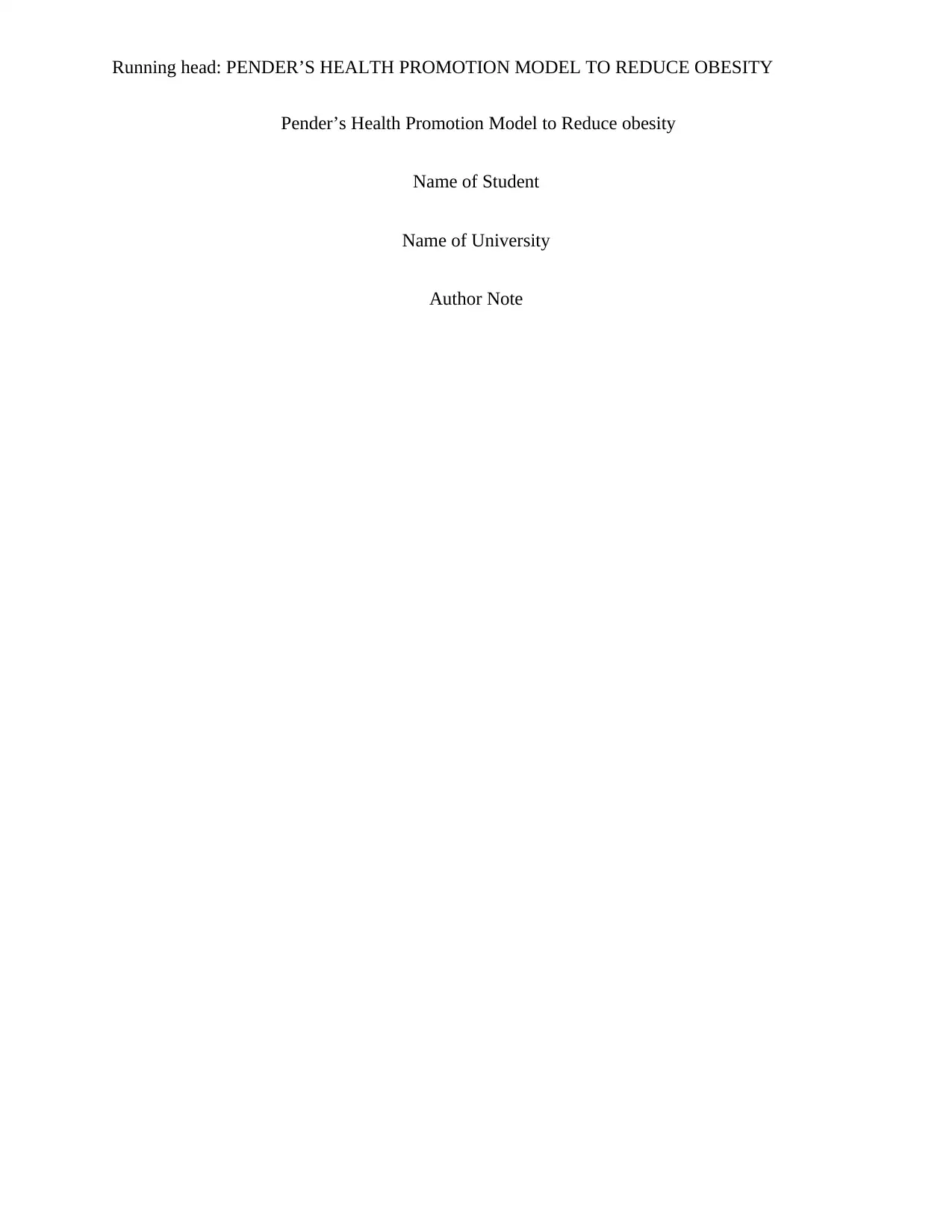
Running head: PENDER’S HEALTH PROMOTION MODEL TO REDUCE OBESITY
Pender’s Health Promotion Model to Reduce obesity
Name of Student
Name of University
Author Note
Pender’s Health Promotion Model to Reduce obesity
Name of Student
Name of University
Author Note
Secure Best Marks with AI Grader
Need help grading? Try our AI Grader for instant feedback on your assignments.
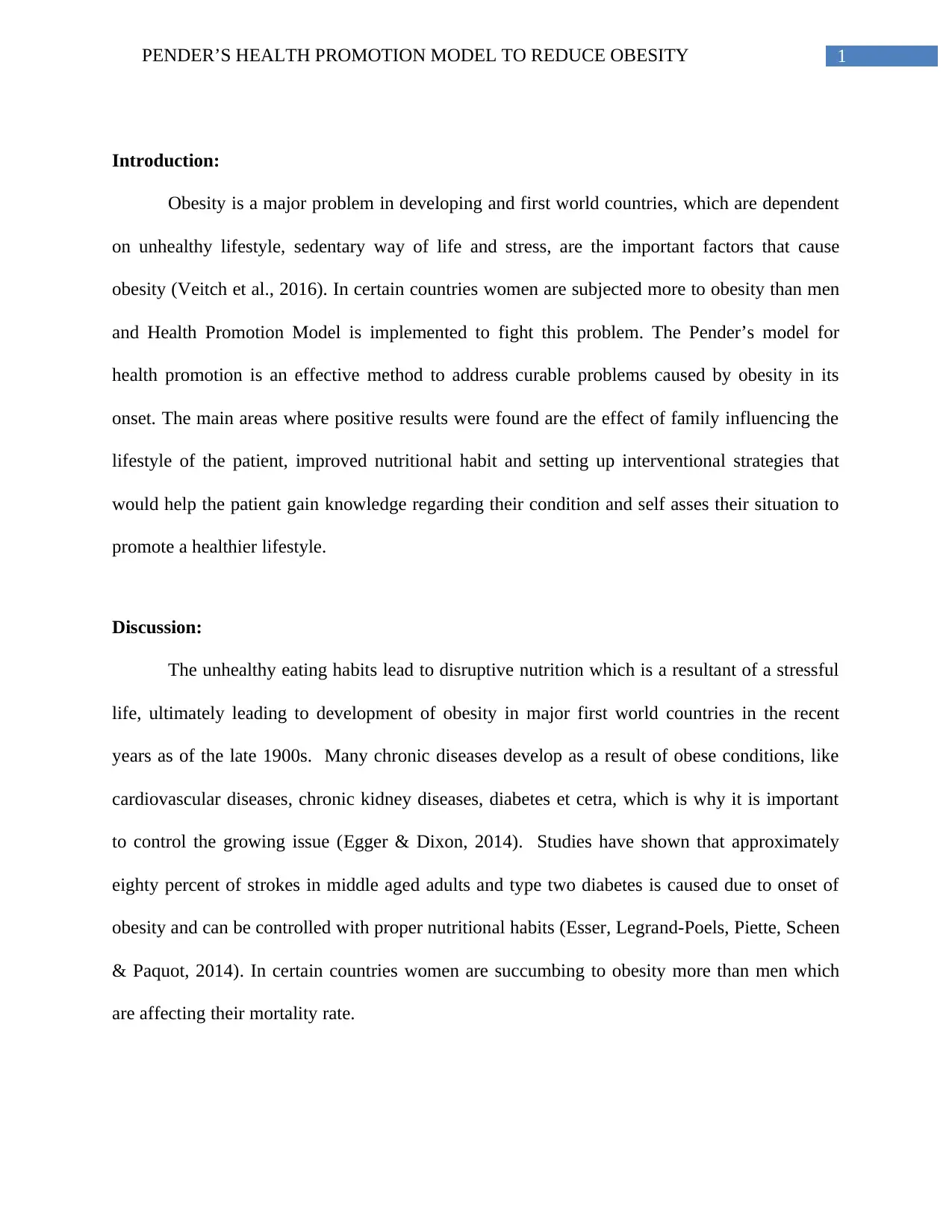
1PENDER’S HEALTH PROMOTION MODEL TO REDUCE OBESITY
Introduction:
Obesity is a major problem in developing and first world countries, which are dependent
on unhealthy lifestyle, sedentary way of life and stress, are the important factors that cause
obesity (Veitch et al., 2016). In certain countries women are subjected more to obesity than men
and Health Promotion Model is implemented to fight this problem. The Pender’s model for
health promotion is an effective method to address curable problems caused by obesity in its
onset. The main areas where positive results were found are the effect of family influencing the
lifestyle of the patient, improved nutritional habit and setting up interventional strategies that
would help the patient gain knowledge regarding their condition and self asses their situation to
promote a healthier lifestyle.
Discussion:
The unhealthy eating habits lead to disruptive nutrition which is a resultant of a stressful
life, ultimately leading to development of obesity in major first world countries in the recent
years as of the late 1900s. Many chronic diseases develop as a result of obese conditions, like
cardiovascular diseases, chronic kidney diseases, diabetes et cetra, which is why it is important
to control the growing issue (Egger & Dixon, 2014). Studies have shown that approximately
eighty percent of strokes in middle aged adults and type two diabetes is caused due to onset of
obesity and can be controlled with proper nutritional habits (Esser, Legrand-Poels, Piette, Scheen
& Paquot, 2014). In certain countries women are succumbing to obesity more than men which
are affecting their mortality rate.
Introduction:
Obesity is a major problem in developing and first world countries, which are dependent
on unhealthy lifestyle, sedentary way of life and stress, are the important factors that cause
obesity (Veitch et al., 2016). In certain countries women are subjected more to obesity than men
and Health Promotion Model is implemented to fight this problem. The Pender’s model for
health promotion is an effective method to address curable problems caused by obesity in its
onset. The main areas where positive results were found are the effect of family influencing the
lifestyle of the patient, improved nutritional habit and setting up interventional strategies that
would help the patient gain knowledge regarding their condition and self asses their situation to
promote a healthier lifestyle.
Discussion:
The unhealthy eating habits lead to disruptive nutrition which is a resultant of a stressful
life, ultimately leading to development of obesity in major first world countries in the recent
years as of the late 1900s. Many chronic diseases develop as a result of obese conditions, like
cardiovascular diseases, chronic kidney diseases, diabetes et cetra, which is why it is important
to control the growing issue (Egger & Dixon, 2014). Studies have shown that approximately
eighty percent of strokes in middle aged adults and type two diabetes is caused due to onset of
obesity and can be controlled with proper nutritional habits (Esser, Legrand-Poels, Piette, Scheen
& Paquot, 2014). In certain countries women are succumbing to obesity more than men which
are affecting their mortality rate.
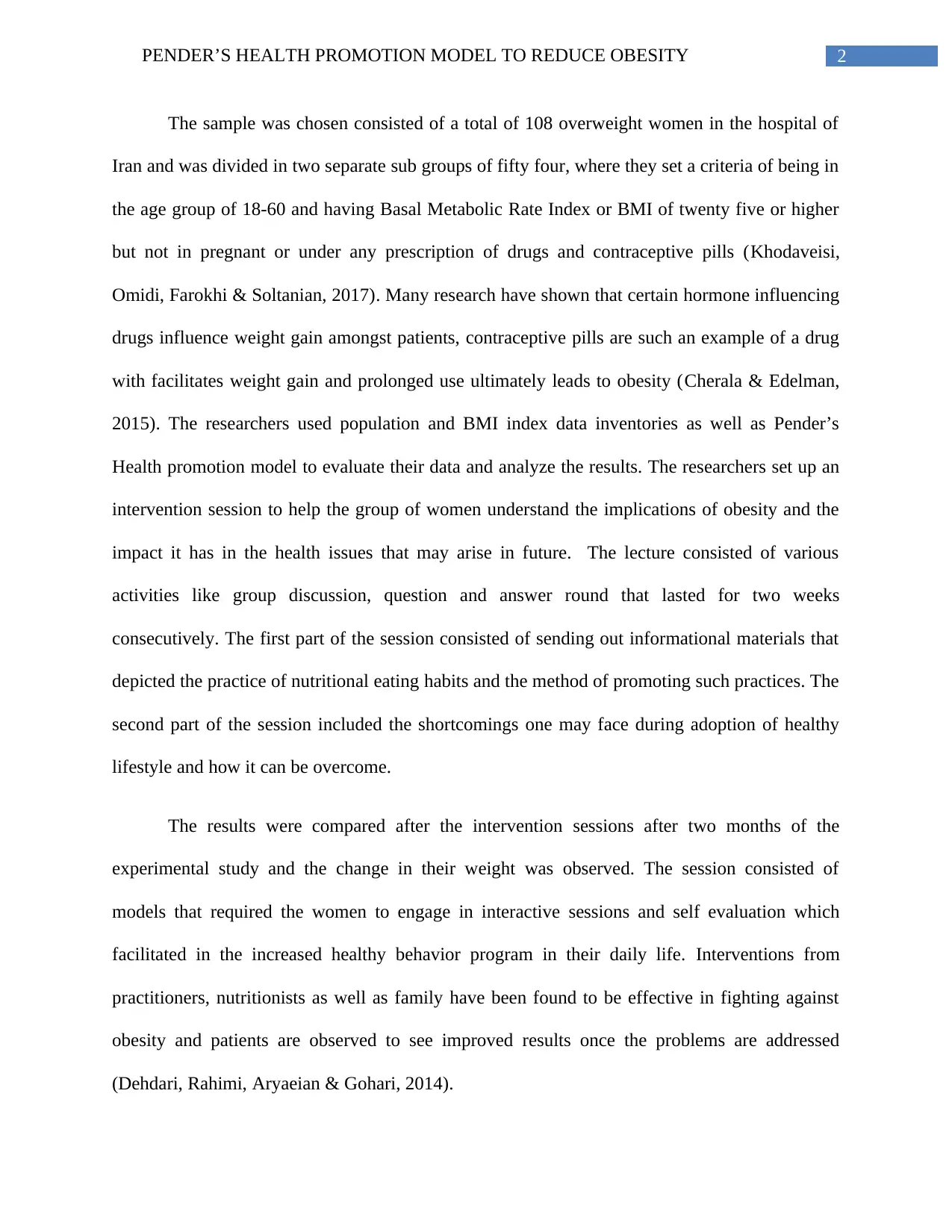
2PENDER’S HEALTH PROMOTION MODEL TO REDUCE OBESITY
The sample was chosen consisted of a total of 108 overweight women in the hospital of
Iran and was divided in two separate sub groups of fifty four, where they set a criteria of being in
the age group of 18-60 and having Basal Metabolic Rate Index or BMI of twenty five or higher
but not in pregnant or under any prescription of drugs and contraceptive pills (Khodaveisi,
Omidi, Farokhi & Soltanian, 2017). Many research have shown that certain hormone influencing
drugs influence weight gain amongst patients, contraceptive pills are such an example of a drug
with facilitates weight gain and prolonged use ultimately leads to obesity (Cherala & Edelman,
2015). The researchers used population and BMI index data inventories as well as Pender’s
Health promotion model to evaluate their data and analyze the results. The researchers set up an
intervention session to help the group of women understand the implications of obesity and the
impact it has in the health issues that may arise in future. The lecture consisted of various
activities like group discussion, question and answer round that lasted for two weeks
consecutively. The first part of the session consisted of sending out informational materials that
depicted the practice of nutritional eating habits and the method of promoting such practices. The
second part of the session included the shortcomings one may face during adoption of healthy
lifestyle and how it can be overcome.
The results were compared after the intervention sessions after two months of the
experimental study and the change in their weight was observed. The session consisted of
models that required the women to engage in interactive sessions and self evaluation which
facilitated in the increased healthy behavior program in their daily life. Interventions from
practitioners, nutritionists as well as family have been found to be effective in fighting against
obesity and patients are observed to see improved results once the problems are addressed
(Dehdari, Rahimi, Aryaeian & Gohari, 2014).
The sample was chosen consisted of a total of 108 overweight women in the hospital of
Iran and was divided in two separate sub groups of fifty four, where they set a criteria of being in
the age group of 18-60 and having Basal Metabolic Rate Index or BMI of twenty five or higher
but not in pregnant or under any prescription of drugs and contraceptive pills (Khodaveisi,
Omidi, Farokhi & Soltanian, 2017). Many research have shown that certain hormone influencing
drugs influence weight gain amongst patients, contraceptive pills are such an example of a drug
with facilitates weight gain and prolonged use ultimately leads to obesity (Cherala & Edelman,
2015). The researchers used population and BMI index data inventories as well as Pender’s
Health promotion model to evaluate their data and analyze the results. The researchers set up an
intervention session to help the group of women understand the implications of obesity and the
impact it has in the health issues that may arise in future. The lecture consisted of various
activities like group discussion, question and answer round that lasted for two weeks
consecutively. The first part of the session consisted of sending out informational materials that
depicted the practice of nutritional eating habits and the method of promoting such practices. The
second part of the session included the shortcomings one may face during adoption of healthy
lifestyle and how it can be overcome.
The results were compared after the intervention sessions after two months of the
experimental study and the change in their weight was observed. The session consisted of
models that required the women to engage in interactive sessions and self evaluation which
facilitated in the increased healthy behavior program in their daily life. Interventions from
practitioners, nutritionists as well as family have been found to be effective in fighting against
obesity and patients are observed to see improved results once the problems are addressed
(Dehdari, Rahimi, Aryaeian & Gohari, 2014).
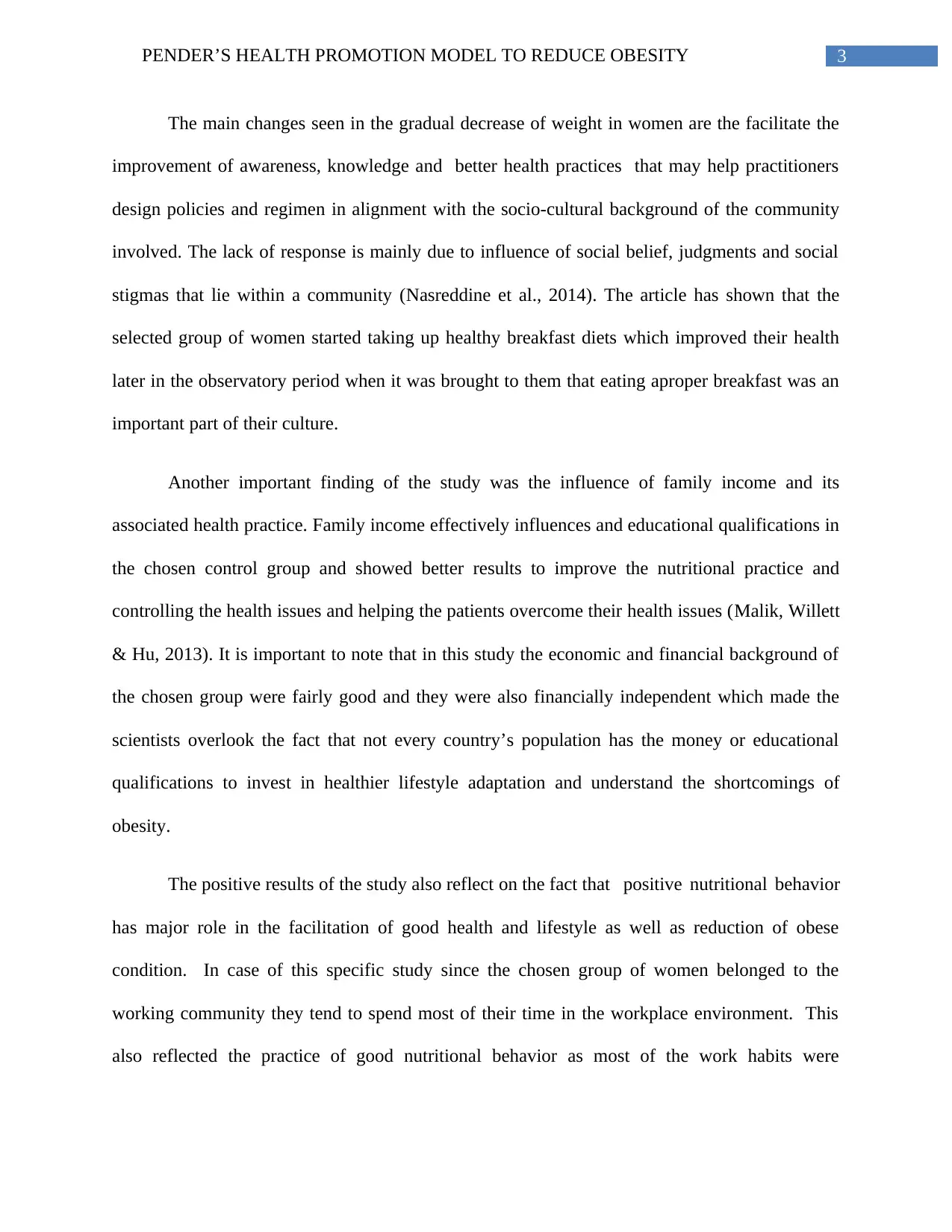
3PENDER’S HEALTH PROMOTION MODEL TO REDUCE OBESITY
The main changes seen in the gradual decrease of weight in women are the facilitate the
improvement of awareness, knowledge and better health practices that may help practitioners
design policies and regimen in alignment with the socio-cultural background of the community
involved. The lack of response is mainly due to influence of social belief, judgments and social
stigmas that lie within a community (Nasreddine et al., 2014). The article has shown that the
selected group of women started taking up healthy breakfast diets which improved their health
later in the observatory period when it was brought to them that eating aproper breakfast was an
important part of their culture.
Another important finding of the study was the influence of family income and its
associated health practice. Family income effectively influences and educational qualifications in
the chosen control group and showed better results to improve the nutritional practice and
controlling the health issues and helping the patients overcome their health issues (Malik, Willett
& Hu, 2013). It is important to note that in this study the economic and financial background of
the chosen group were fairly good and they were also financially independent which made the
scientists overlook the fact that not every country’s population has the money or educational
qualifications to invest in healthier lifestyle adaptation and understand the shortcomings of
obesity.
The positive results of the study also reflect on the fact that positive nutritional behavior
has major role in the facilitation of good health and lifestyle as well as reduction of obese
condition. In case of this specific study since the chosen group of women belonged to the
working community they tend to spend most of their time in the workplace environment. This
also reflected the practice of good nutritional behavior as most of the work habits were
The main changes seen in the gradual decrease of weight in women are the facilitate the
improvement of awareness, knowledge and better health practices that may help practitioners
design policies and regimen in alignment with the socio-cultural background of the community
involved. The lack of response is mainly due to influence of social belief, judgments and social
stigmas that lie within a community (Nasreddine et al., 2014). The article has shown that the
selected group of women started taking up healthy breakfast diets which improved their health
later in the observatory period when it was brought to them that eating aproper breakfast was an
important part of their culture.
Another important finding of the study was the influence of family income and its
associated health practice. Family income effectively influences and educational qualifications in
the chosen control group and showed better results to improve the nutritional practice and
controlling the health issues and helping the patients overcome their health issues (Malik, Willett
& Hu, 2013). It is important to note that in this study the economic and financial background of
the chosen group were fairly good and they were also financially independent which made the
scientists overlook the fact that not every country’s population has the money or educational
qualifications to invest in healthier lifestyle adaptation and understand the shortcomings of
obesity.
The positive results of the study also reflect on the fact that positive nutritional behavior
has major role in the facilitation of good health and lifestyle as well as reduction of obese
condition. In case of this specific study since the chosen group of women belonged to the
working community they tend to spend most of their time in the workplace environment. This
also reflected the practice of good nutritional behavior as most of the work habits were
Secure Best Marks with AI Grader
Need help grading? Try our AI Grader for instant feedback on your assignments.
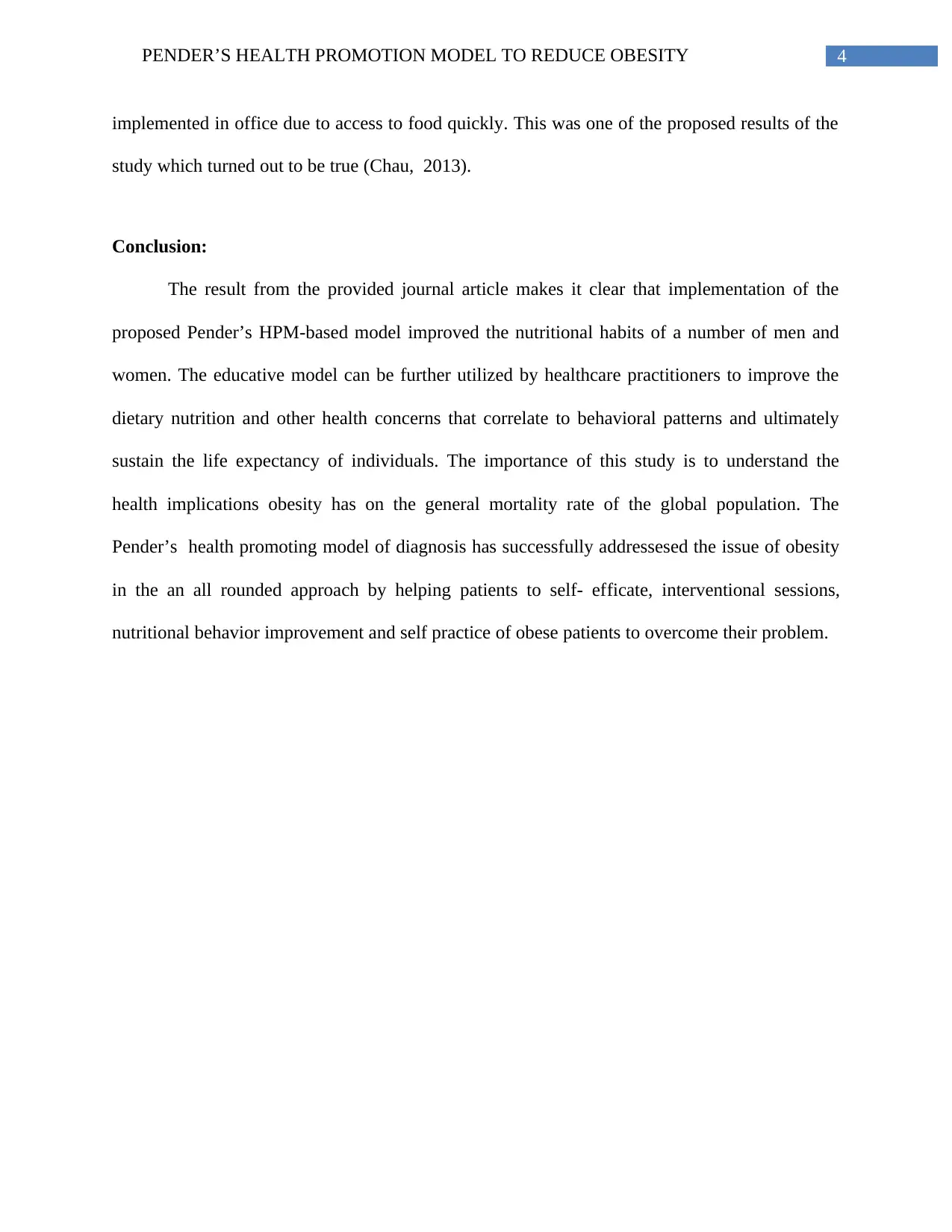
4PENDER’S HEALTH PROMOTION MODEL TO REDUCE OBESITY
implemented in office due to access to food quickly. This was one of the proposed results of the
study which turned out to be true (Chau, 2013).
Conclusion:
The result from the provided journal article makes it clear that implementation of the
proposed Pender’s HPM-based model improved the nutritional habits of a number of men and
women. The educative model can be further utilized by healthcare practitioners to improve the
dietary nutrition and other health concerns that correlate to behavioral patterns and ultimately
sustain the life expectancy of individuals. The importance of this study is to understand the
health implications obesity has on the general mortality rate of the global population. The
Pender’s health promoting model of diagnosis has successfully addressesed the issue of obesity
in the an all rounded approach by helping patients to self- efficate, interventional sessions,
nutritional behavior improvement and self practice of obese patients to overcome their problem.
implemented in office due to access to food quickly. This was one of the proposed results of the
study which turned out to be true (Chau, 2013).
Conclusion:
The result from the provided journal article makes it clear that implementation of the
proposed Pender’s HPM-based model improved the nutritional habits of a number of men and
women. The educative model can be further utilized by healthcare practitioners to improve the
dietary nutrition and other health concerns that correlate to behavioral patterns and ultimately
sustain the life expectancy of individuals. The importance of this study is to understand the
health implications obesity has on the general mortality rate of the global population. The
Pender’s health promoting model of diagnosis has successfully addressesed the issue of obesity
in the an all rounded approach by helping patients to self- efficate, interventional sessions,
nutritional behavior improvement and self practice of obese patients to overcome their problem.
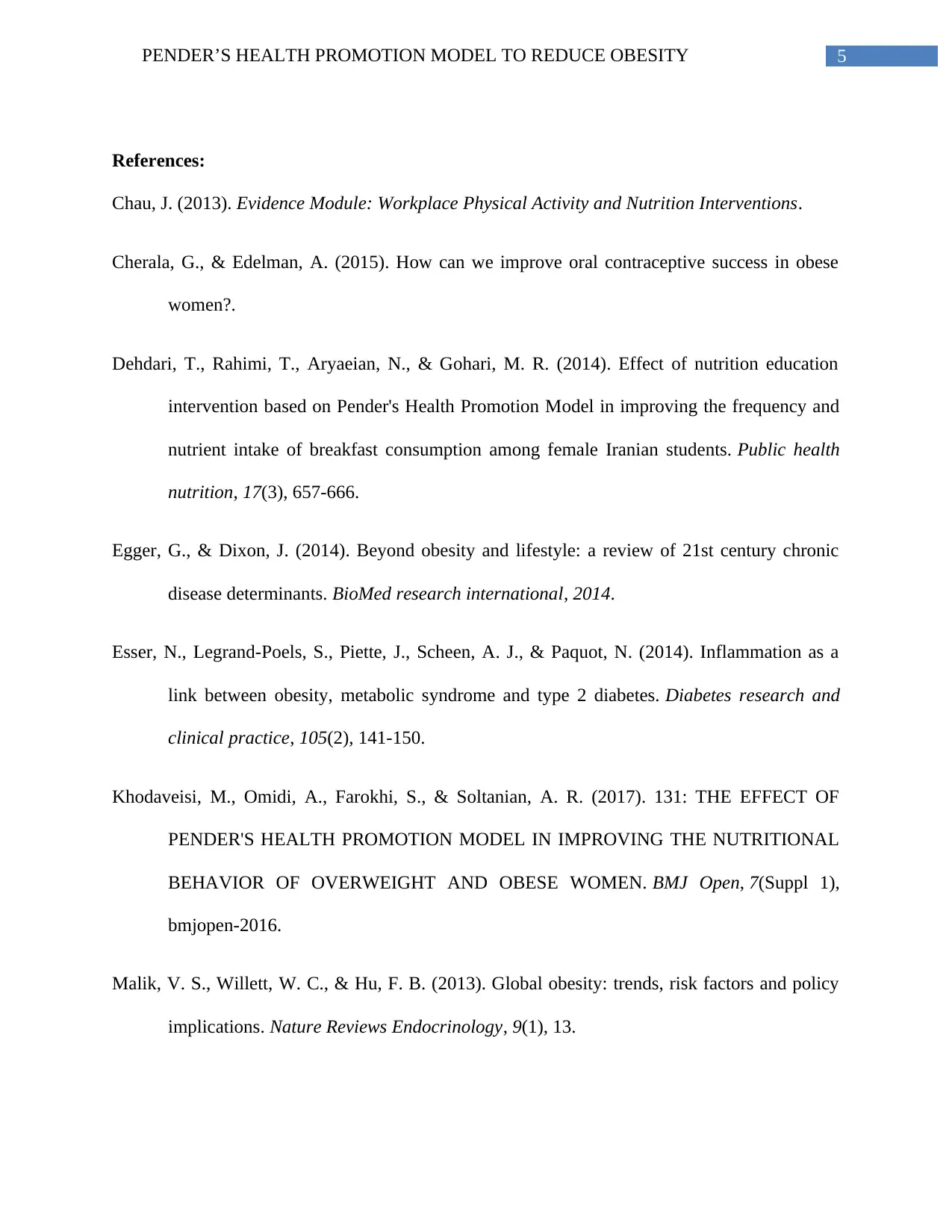
5PENDER’S HEALTH PROMOTION MODEL TO REDUCE OBESITY
References:
Chau, J. (2013). Evidence Module: Workplace Physical Activity and Nutrition Interventions.
Cherala, G., & Edelman, A. (2015). How can we improve oral contraceptive success in obese
women?.
Dehdari, T., Rahimi, T., Aryaeian, N., & Gohari, M. R. (2014). Effect of nutrition education
intervention based on Pender's Health Promotion Model in improving the frequency and
nutrient intake of breakfast consumption among female Iranian students. Public health
nutrition, 17(3), 657-666.
Egger, G., & Dixon, J. (2014). Beyond obesity and lifestyle: a review of 21st century chronic
disease determinants. BioMed research international, 2014.
Esser, N., Legrand-Poels, S., Piette, J., Scheen, A. J., & Paquot, N. (2014). Inflammation as a
link between obesity, metabolic syndrome and type 2 diabetes. Diabetes research and
clinical practice, 105(2), 141-150.
Khodaveisi, M., Omidi, A., Farokhi, S., & Soltanian, A. R. (2017). 131: THE EFFECT OF
PENDER'S HEALTH PROMOTION MODEL IN IMPROVING THE NUTRITIONAL
BEHAVIOR OF OVERWEIGHT AND OBESE WOMEN. BMJ Open, 7(Suppl 1),
bmjopen-2016.
Malik, V. S., Willett, W. C., & Hu, F. B. (2013). Global obesity: trends, risk factors and policy
implications. Nature Reviews Endocrinology, 9(1), 13.
References:
Chau, J. (2013). Evidence Module: Workplace Physical Activity and Nutrition Interventions.
Cherala, G., & Edelman, A. (2015). How can we improve oral contraceptive success in obese
women?.
Dehdari, T., Rahimi, T., Aryaeian, N., & Gohari, M. R. (2014). Effect of nutrition education
intervention based on Pender's Health Promotion Model in improving the frequency and
nutrient intake of breakfast consumption among female Iranian students. Public health
nutrition, 17(3), 657-666.
Egger, G., & Dixon, J. (2014). Beyond obesity and lifestyle: a review of 21st century chronic
disease determinants. BioMed research international, 2014.
Esser, N., Legrand-Poels, S., Piette, J., Scheen, A. J., & Paquot, N. (2014). Inflammation as a
link between obesity, metabolic syndrome and type 2 diabetes. Diabetes research and
clinical practice, 105(2), 141-150.
Khodaveisi, M., Omidi, A., Farokhi, S., & Soltanian, A. R. (2017). 131: THE EFFECT OF
PENDER'S HEALTH PROMOTION MODEL IN IMPROVING THE NUTRITIONAL
BEHAVIOR OF OVERWEIGHT AND OBESE WOMEN. BMJ Open, 7(Suppl 1),
bmjopen-2016.
Malik, V. S., Willett, W. C., & Hu, F. B. (2013). Global obesity: trends, risk factors and policy
implications. Nature Reviews Endocrinology, 9(1), 13.
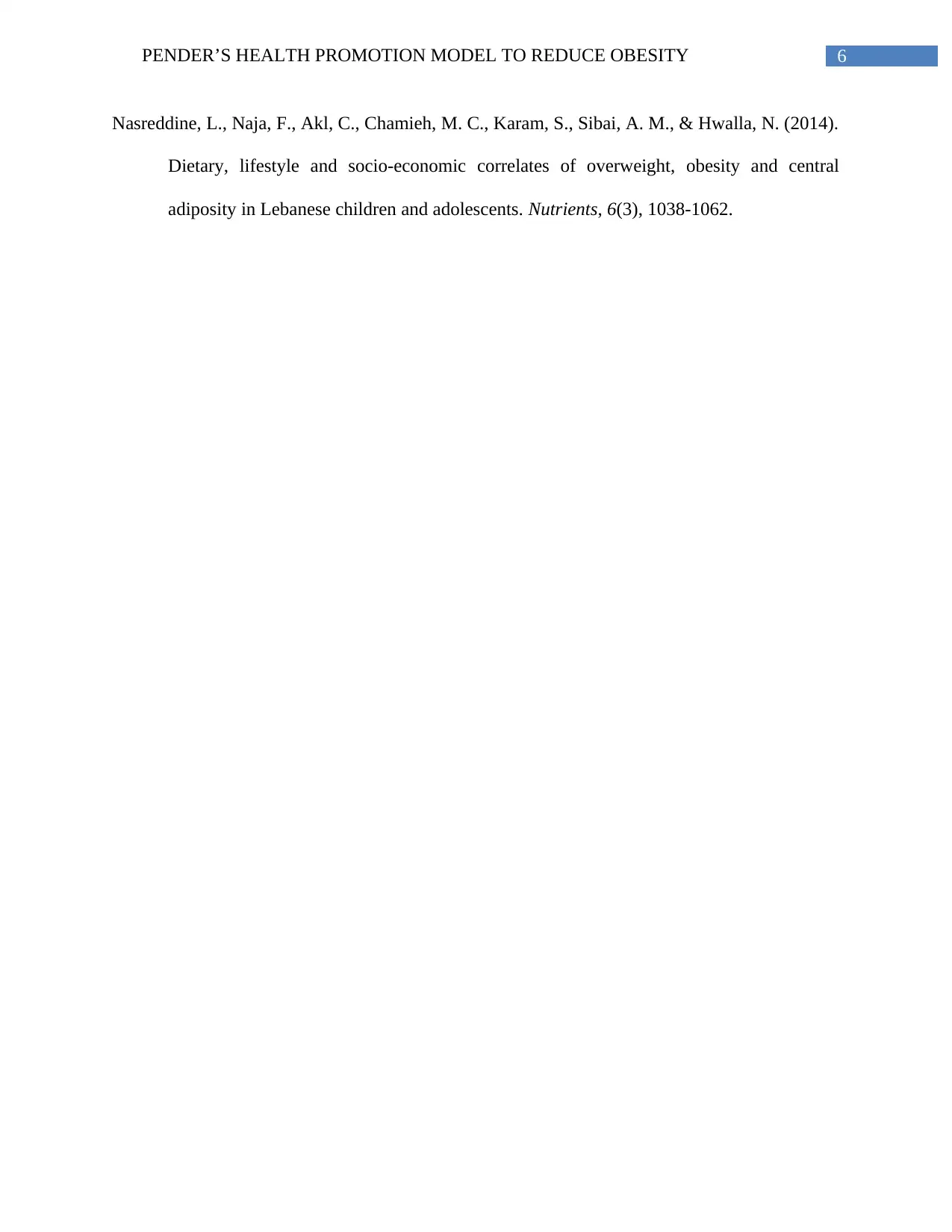
6PENDER’S HEALTH PROMOTION MODEL TO REDUCE OBESITY
Nasreddine, L., Naja, F., Akl, C., Chamieh, M. C., Karam, S., Sibai, A. M., & Hwalla, N. (2014).
Dietary, lifestyle and socio-economic correlates of overweight, obesity and central
adiposity in Lebanese children and adolescents. Nutrients, 6(3), 1038-1062.
Nasreddine, L., Naja, F., Akl, C., Chamieh, M. C., Karam, S., Sibai, A. M., & Hwalla, N. (2014).
Dietary, lifestyle and socio-economic correlates of overweight, obesity and central
adiposity in Lebanese children and adolescents. Nutrients, 6(3), 1038-1062.
1 out of 7
Your All-in-One AI-Powered Toolkit for Academic Success.
+13062052269
info@desklib.com
Available 24*7 on WhatsApp / Email
![[object Object]](/_next/static/media/star-bottom.7253800d.svg)
Unlock your academic potential
© 2024 | Zucol Services PVT LTD | All rights reserved.





